ECO mode JEEP RENEGADE 2015 1.G User Guide
[x] Cancel search | Manufacturer: JEEP, Model Year: 2015, Model line: RENEGADE, Model: JEEP RENEGADE 2015 1.GPages: 678, PDF Size: 29.84 MB
Page 183 of 678
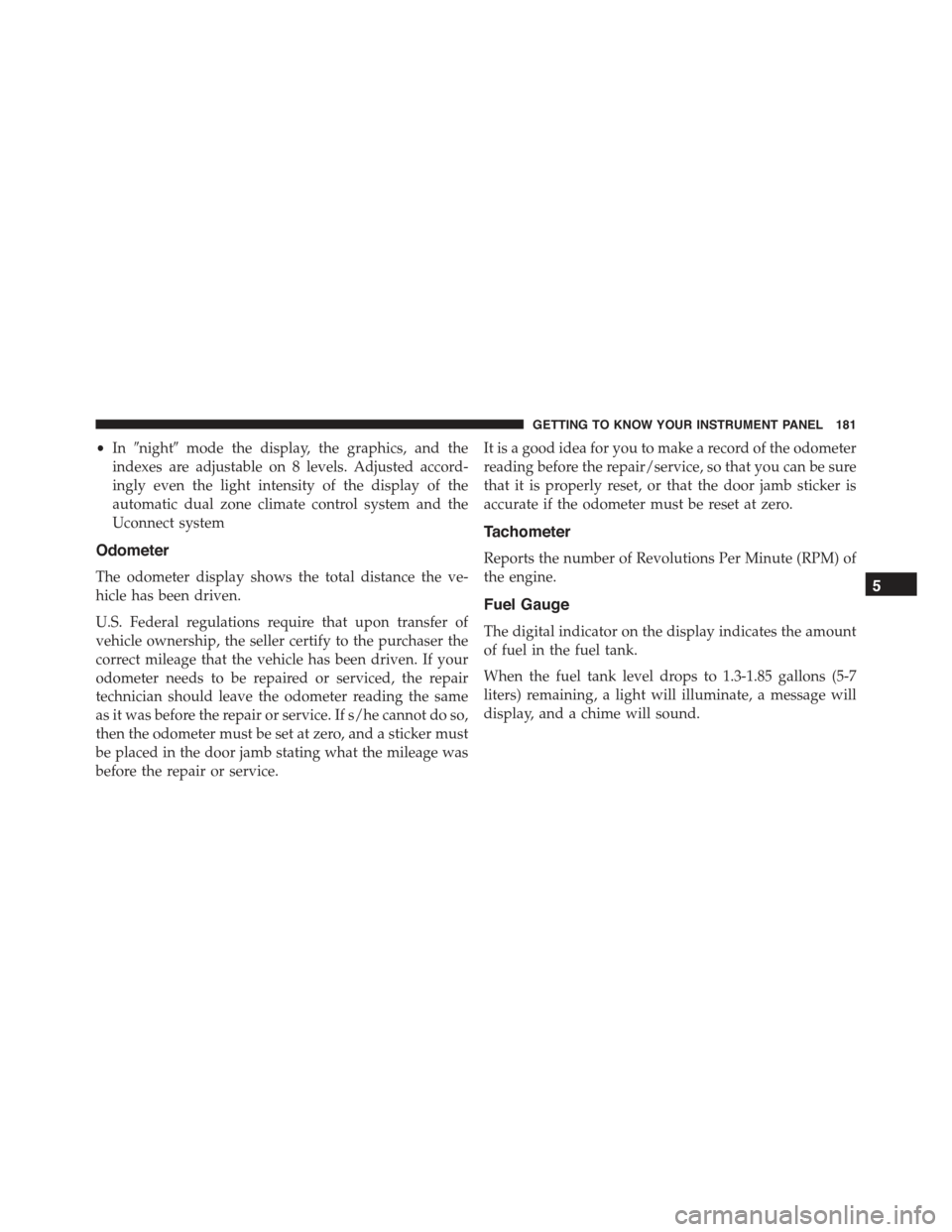
•In#night#mode the display, the graphics, and the
indexes are adjustable on 8 levels. Adjusted accord-
ingly even the light intensity of the display of the
automatic dual zone climate control system and the
Uconnect system
Odometer
The odometer display shows the total distance the ve-
hicle has been driven.
U.S. Federal regulations require that upon transfer of
vehicle ownership, the seller certify to the purchaser the
correct mileage that the vehicle has been driven. If your
odometer needs to be repaired or serviced, the repair
technician should leave the odometer reading the same
as it was before the repair or service. If s/he cannot do so,
then the odometer must be set at zero, and a sticker must
be placed in the door jamb stating what the mileage was
before the repair or service.
It is a good idea for you to make a record of the odometer
reading before the repair/service, so that you can be sure
that it is properly reset, or that the door jamb sticker is
accurate if the odometer must be reset at zero.
Tachometer
Reports the number of Revolutions Per Minute (RPM) of
the engine.
Fuel Gauge
The digital indicator on the display indicates the amount
of fuel in the fuel tank.
When the fuel tank level drops to 1.3-1.85 gallons (5-7
liters) remaining, a light will illuminate, a message will
display, and a chime will sound.
5
GETTING TO KNOW YOUR INSTRUMENT PANEL 181
Page 213 of 678
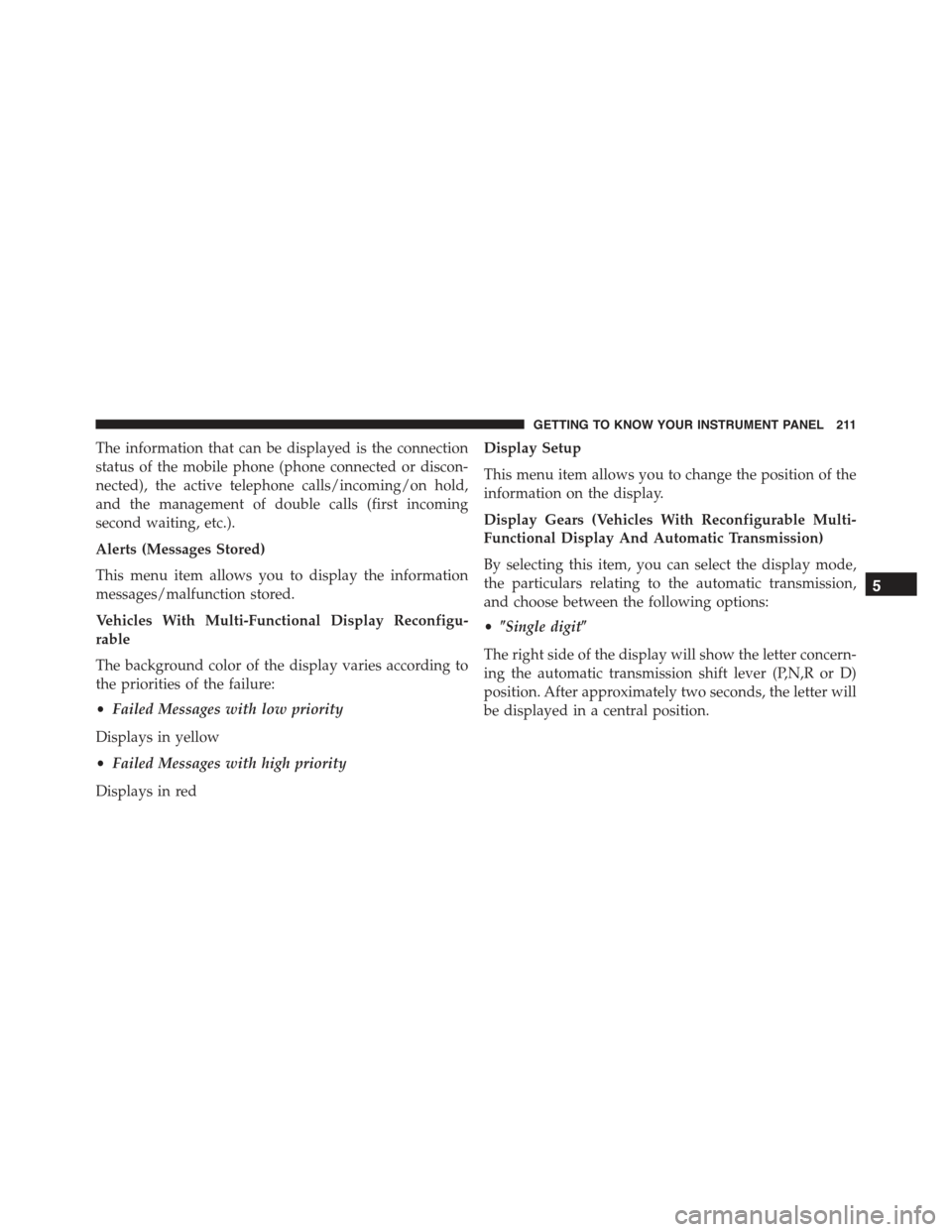
The information that can be displayed is the connection
status of the mobile phone (phone connected or discon-
nected), the active telephone calls/incoming/on hold,
and the management of double calls (first incoming
second waiting, etc.).
Alerts (Messages Stored)
This menu item allows you to display the information
messages/malfunction stored.
Vehicles With Multi-Functional Display Reconfigu-
rable
The background color of the display varies according to
the priorities of the failure:
•Failed Messages with low priority
Displays in yellow
•Failed Messages with high priority
Displays in red
Display Setup
This menu item allows you to change the position of the
information on the display.
Display Gears (Vehicles With Reconfigurable Multi-
Functional Display And Automatic Transmission)
By selecting this item, you can select the display mode,
the particulars relating to the automatic transmission,
and choose between the following options:
•$Single digit$
The right side of the display will show the letter concern-
ing the automatic transmission shift lever (P,N,R or D)
position. After approximately two seconds, the letter will
be displayed in a central position.
5
GETTING TO KNOW YOUR INSTRUMENT PANEL 211
Page 215 of 678
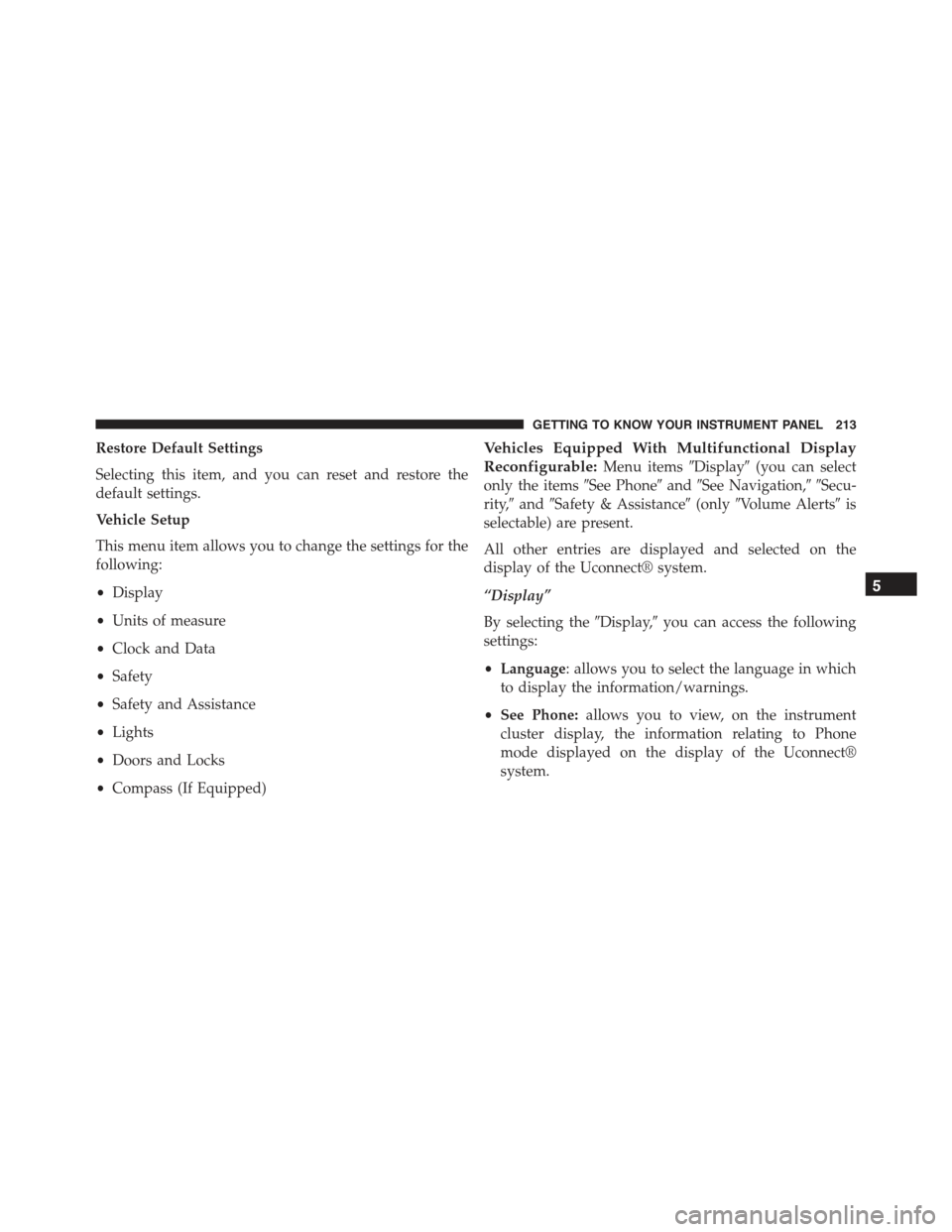
Restore Default Settings
Selecting this item, and you can reset and restore the
default settings.
Vehicle Setup
This menu item allows you to change the settings for the
following:
•Display
•Units of measure
•Clock and Data
•Safety
•Safety and Assistance
•Lights
•Doors and Locks
•Compass (If Equipped)
Vehicles Equipped With Multifunctional Display
Reconfigurable:Menu items#Display#(you can select
only the items#See Phone#and#See Navigation,##Secu-
rity,#and#Safety & Assistance#(only#Volume Alerts#is
selectable) are present.
All other entries are displayed and selected on the
display of the Uconnect® system.
“Display”
By selecting the#Display,#you can access the following
settings:
•Language: allows you to select the language in which
to display the information/warnings.
•See Phone:allows you to view, on the instrument
cluster display, the information relating to Phone
mode displayed on the display of the Uconnect®
system.
5
GETTING TO KNOW YOUR INSTRUMENT PANEL 213
Page 229 of 678
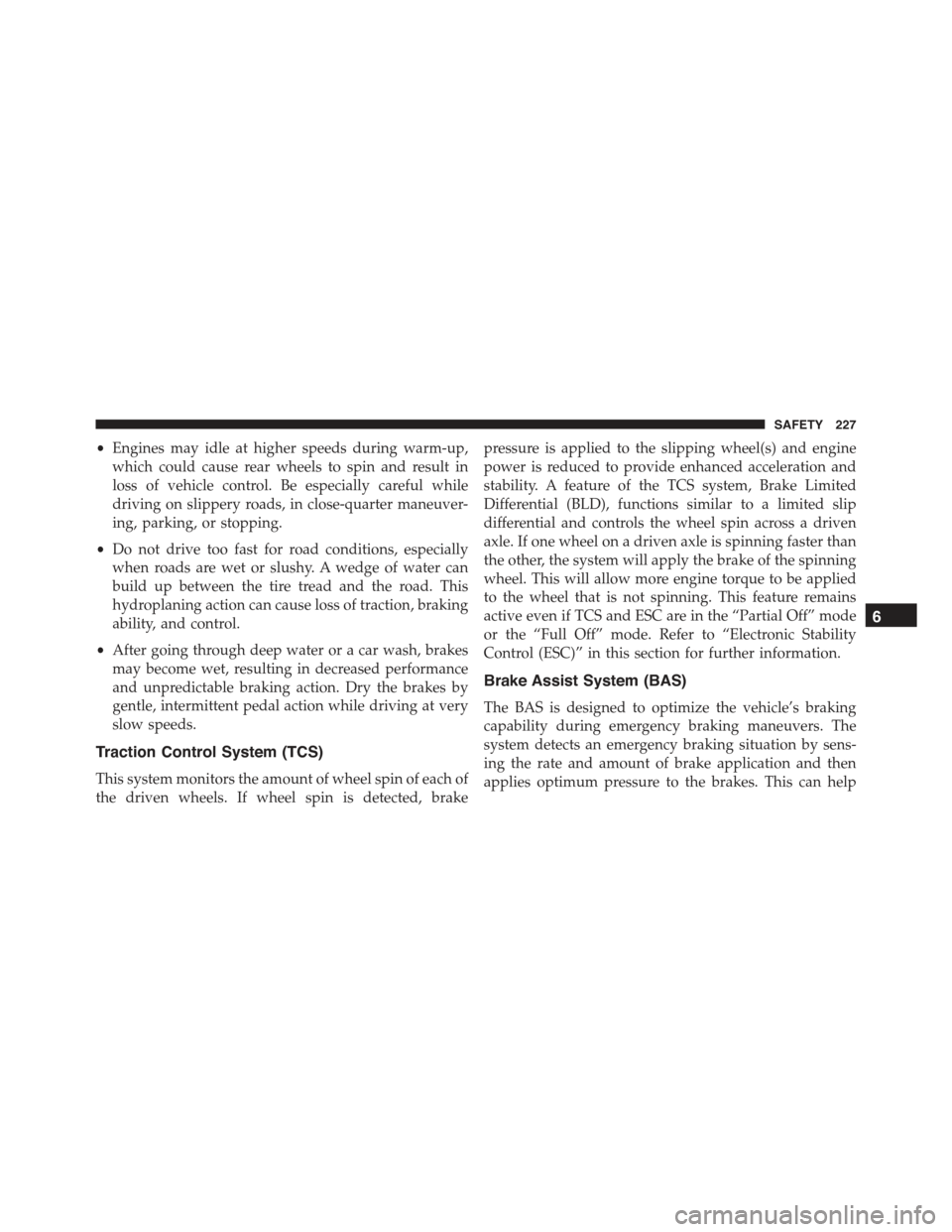
•Engines may idle at higher speeds during warm-up,
which could cause rear wheels to spin and result in
loss of vehicle control. Be especially careful while
driving on slippery roads, in close-quarter maneuver-
ing, parking, or stopping.
•Do not drive too fast for road conditions, especially
when roads are wet or slushy. A wedge of water can
build up between the tire tread and the road. This
hydroplaning action can cause loss of traction, braking
ability, and control.
•After going through deep water or a car wash, brakes
may become wet, resulting in decreased performance
and unpredictable braking action. Dry the brakes by
gentle, intermittent pedal action while driving at very
slow speeds.
Traction Control System (TCS)
This system monitors the amount of wheel spin of each of
the driven wheels. If wheel spin is detected, brake
pressure is applied to the slipping wheel(s) and engine
power is reduced to provide enhanced acceleration and
stability. A feature of the TCS system, Brake Limited
Differential (BLD), functions similar to a limited slip
differential and controls the wheel spin across a driven
axle. If one wheel on a driven axle is spinning faster than
the other, the system will apply the brake of the spinning
wheel. This will allow more engine torque to be applied
to the wheel that is not spinning. This feature remains
active even if TCS and ESC are in the “Partial Off” mode
or the “Full Off” mode. Refer to “Electronic Stability
Control (ESC)” in this section for further information.
Brake Assist System (BAS)
The BAS is designed to optimize the vehicle’s braking
capability during emergency braking maneuvers. The
system detects an emergency braking situation by sens-
ing the rate and amount of brake application and then
applies optimum pressure to the brakes. This can help
6
SAFETY 227
Page 237 of 678
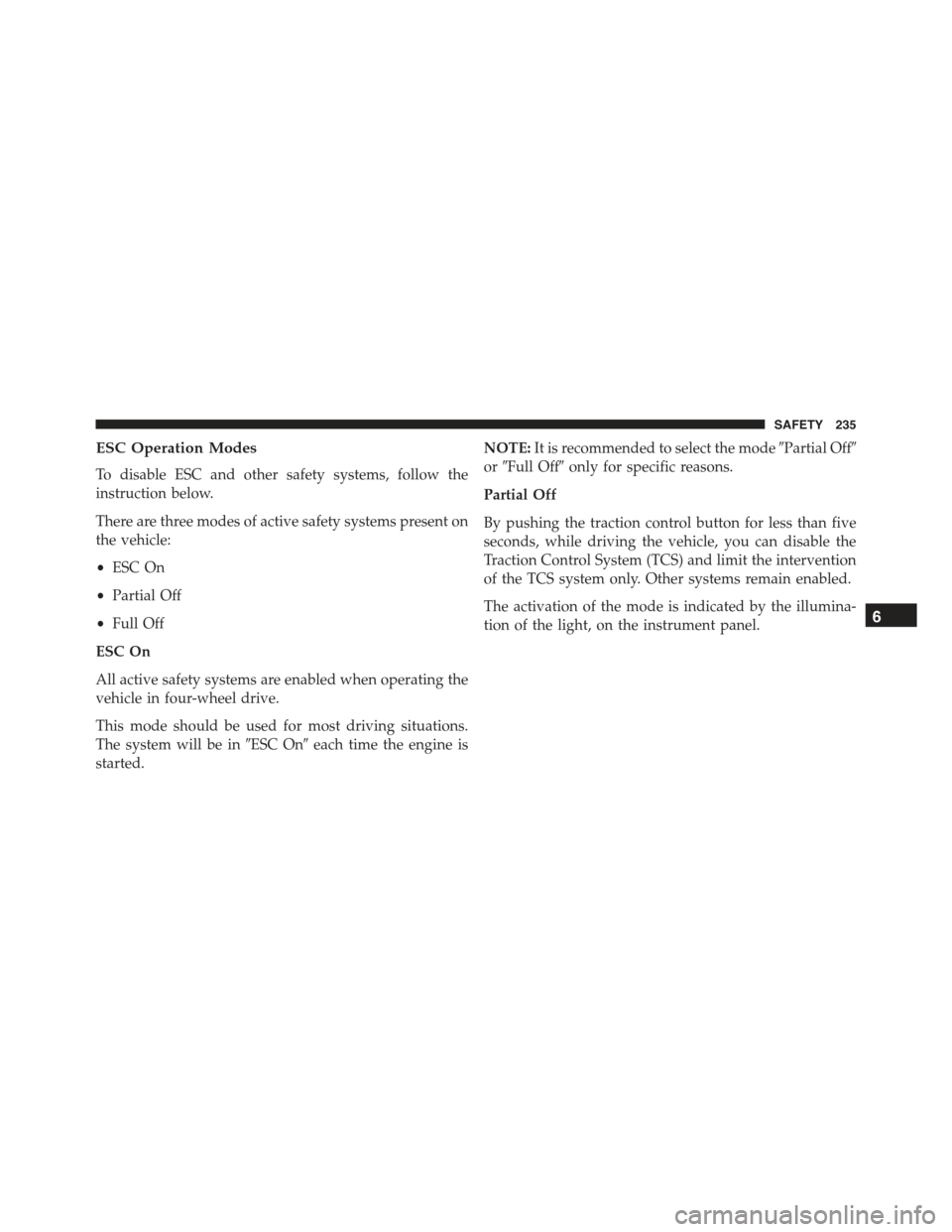
ESC Operation Modes
To disable ESC and other safety systems, follow the
instruction below.
There are three modes of active safety systems present on
the vehicle:
•ESC On
•Partial Off
•Full Off
ESC On
All active safety systems are enabled when operating the
vehicle in four-wheel drive.
This mode should be used for most driving situations.
The system will be in#ESC On#each time the engine is
started.
NOTE:It is recommended to select the mode#Partial Off#
or#Full Off#only for specific reasons.
Partial Off
By pushing the traction control button for less than five
seconds, while driving the vehicle, you can disable the
Traction Control System (TCS) and limit the intervention
of the TCS system only. Other systems remain enabled.
The activation of the mode is indicated by the illumina-
tion of the light, on the instrument panel.6
SAFETY 235
Page 239 of 678
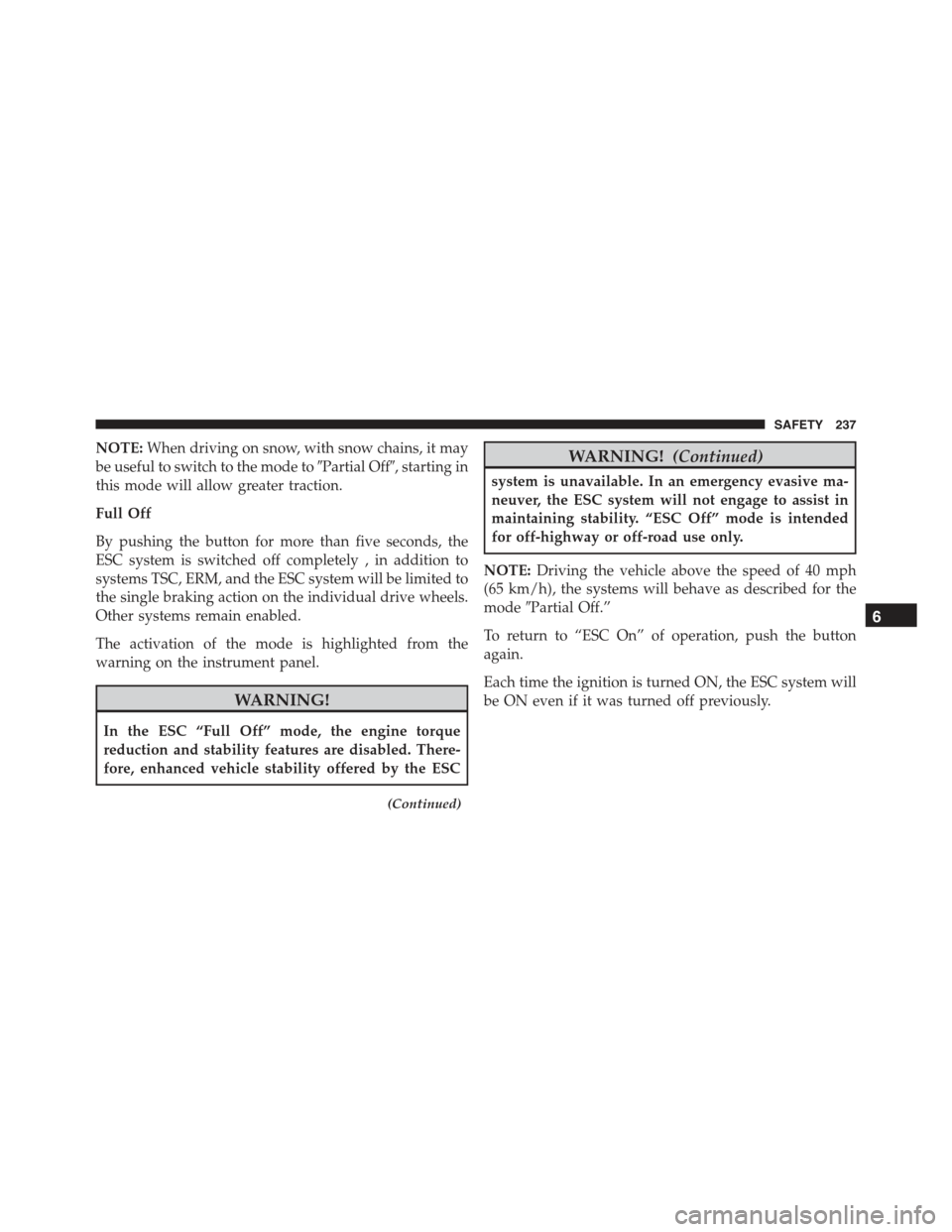
NOTE:When driving on snow, with snow chains, it may
be useful to switch to the mode to#Partial Off#, starting in
this mode will allow greater traction.
Full Off
By pushing the button for more than five seconds, the
ESC system is switched off completely , in addition to
systems TSC, ERM, and the ESC system will be limited to
the single braking action on the individual drive wheels.
Other systems remain enabled.
The activation of the mode is highlighted from the
warning on the instrument panel.
WARNING!
In the ESC “Full Off” mode, the engine torque
reduction and stability features are disabled. There-
fore, enhanced vehicle stability offered by the ESC
(Continued)
WARNING!(Continued)
system is unavailable. In an emergency evasive ma-
neuver, the ESC system will not engage to assist in
maintaining stability. “ESC Off” mode is intended
for off-highway or off-road use only.
NOTE:Driving the vehicle above the speed of 40 mph
(65 km/h), the systems will behave as described for the
mode#Partial Off.”
To return to “ESC On” of operation, push the button
again.
Each time the ignition is turned ON, the ESC system will
be ON even if it was turned off previously.
6
SAFETY 237
Page 240 of 678
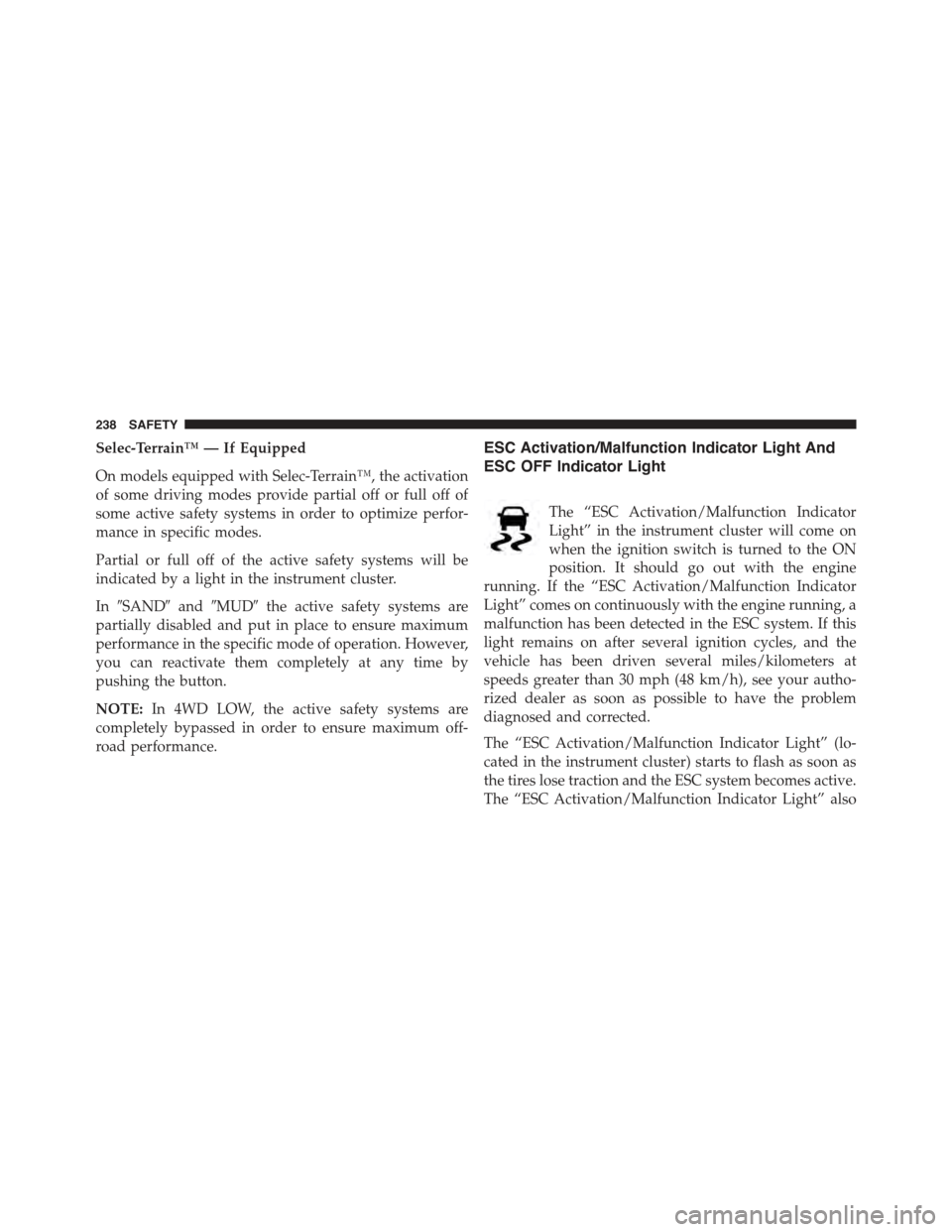
Selec-Terrain™ — If Equipped
On models equipped with Selec-Terrain™, the activation
of some driving modes provide partial off or full off of
some active safety systems in order to optimize perfor-
mance in specific modes.
Partial or full off of the active safety systems will be
indicated by a light in the instrument cluster.
In#SAND#and#MUD#the active safety systems are
partially disabled and put in place to ensure maximum
performance in the specific mode of operation. However,
you can reactivate them completely at any time by
pushing the button.
NOTE:In 4WD LOW, the active safety systems are
completely bypassed in order to ensure maximum off-
road performance.
ESC Activation/Malfunction Indicator Light And
ESC OFF Indicator Light
The “ESC Activation/Malfunction Indicator
Light” in the instrument cluster will come on
when the ignition switch is turned to the ON
position. It should go out with the engine
running. If the “ESC Activation/Malfunction Indicator
Light” comes on continuously with the engine running, a
malfunction has been detected in the ESC system. If this
light remains on after several ignition cycles, and the
vehicle has been driven several miles/kilometers at
speeds greater than 30 mph (48 km/h), see your autho-
rized dealer as soon as possible to have the problem
diagnosed and corrected.
The “ESC Activation/Malfunction Indicator Light” (lo-
cated in the instrument cluster) starts to flash as soon as
the tires lose traction and the ESC system becomes active.
The “ESC Activation/Malfunction Indicator Light” also
238 SAFETY
Page 242 of 678
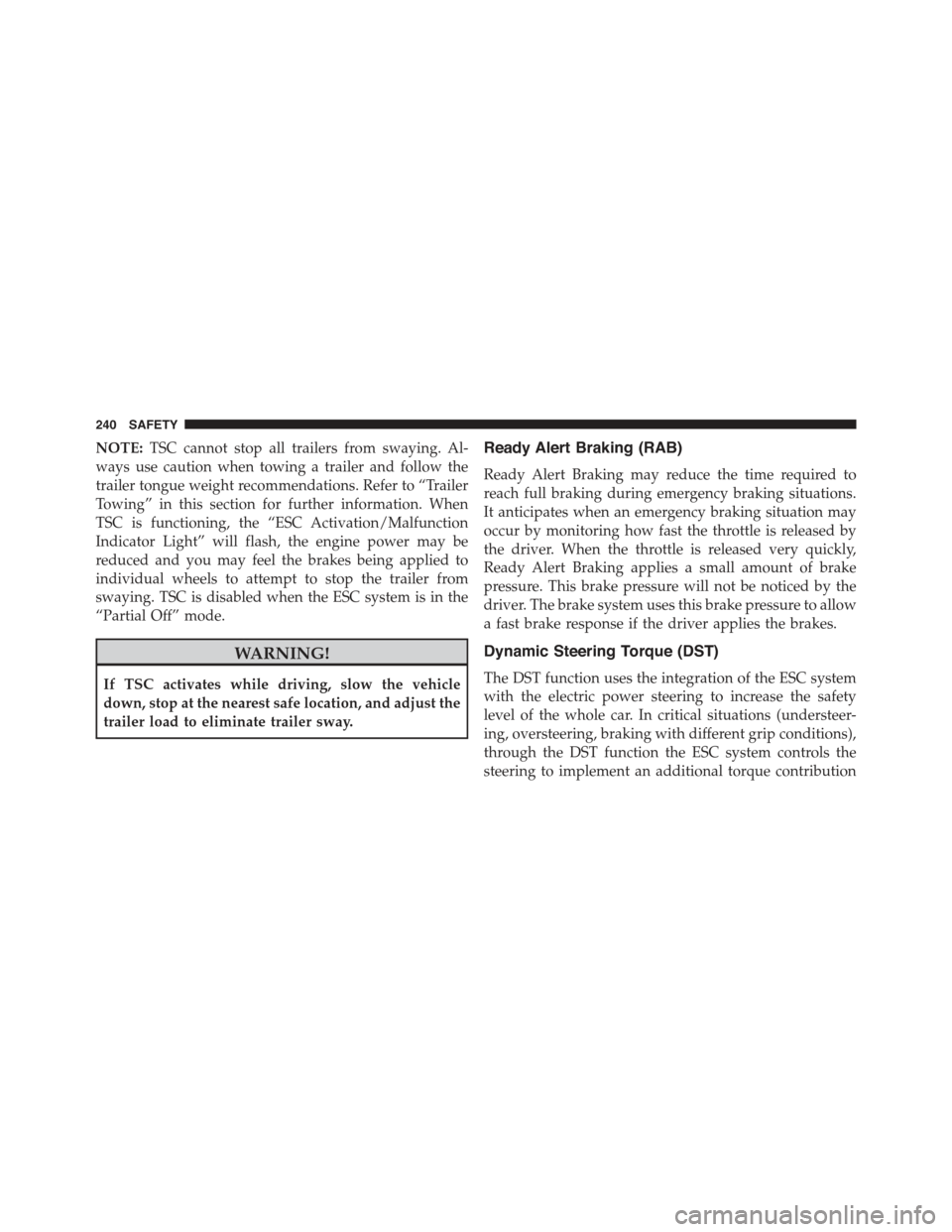
NOTE:TSC cannot stop all trailers from swaying. Al-
ways use caution when towing a trailer and follow the
trailer tongue weight recommendations. Refer to “Trailer
Towing” in this section for further information. When
TSC is functioning, the “ESC Activation/Malfunction
Indicator Light” will flash, the engine power may be
reduced and you may feel the brakes being applied to
individual wheels to attempt to stop the trailer from
swaying. TSC is disabled when the ESC system is in the
“Partial Off” mode.
WARNING!
If TSC activates while driving, slow the vehicle
down, stop at the nearest safe location, and adjust the
trailer load to eliminate trailer sway.
Ready Alert Braking (RAB)
Ready Alert Braking may reduce the time required to
reach full braking during emergency braking situations.
It anticipates when an emergency braking situation may
occur by monitoring how fast the throttle is released by
the driver. When the throttle is released very quickly,
Ready Alert Braking applies a small amount of brake
pressure. This brake pressure will not be noticed by the
driver. The brake system uses this brake pressure to allow
a fast brake response if the driver applies the brakes.
Dynamic Steering Torque (DST)
The DST function uses the integration of the ESC system
with the electric power steering to increase the safety
level of the whole car. In critical situations (understeer-
ing, oversteering, braking with different grip conditions),
through the DST function the ESC system controls the
steering to implement an additional torque contribution
240 SAFETY
Page 308 of 678

Installing A Child Restraint With A Switchable
Automatic Locking Retractor (ALR)
1. Place the child seat in the center of the seating
position. For some second row seats, you may need to
recline the seat and/or raise the head restraint to get a
better fit. If the rear seat can be moved forward and
rearward in the vehicle, you may wish to move it to its
rear-most position to make room for the child seat.
You may also move the front seat forward to allow
more room for the child seat.
2. Pull enough of the seat belt webbing from the retractor
to pass it through the seat belt path of the child
restraint. Do not twist the belt webbing in the belt
path.
3. Slide the latch plate into the buckle until you hear a
“click.”
4. Pull on the webbing to make the lap portion tight
against the child seat.
5. To lock the seat belt, pull down on the shoulder part of
the seat belt until you have pulled all the seat belt
webbing out of the retractor. Then, allow the webbing
to retract back into the retractor. As the webbing
retracts, you will hear a clicking sound. This means the
seat belt is now in the Automatic Locking mode.
6. Try to pull the webbing out of the retractor. If it is
locked, you should not be able to pull out any web-
bing. If the retractor is not locked, repeat step 5.
7. Finally, pull up on any excess webbing to tighten the
lap portion around the child restraint while you push
the child restraint rearward and downward into the
vehicle seat.
8. If the child restraint has a top tether strap and the
seating position has a top tether anchorage, connect
the tether strap to the anchorage and tighten the tether
306 SAFETY
Page 313 of 678
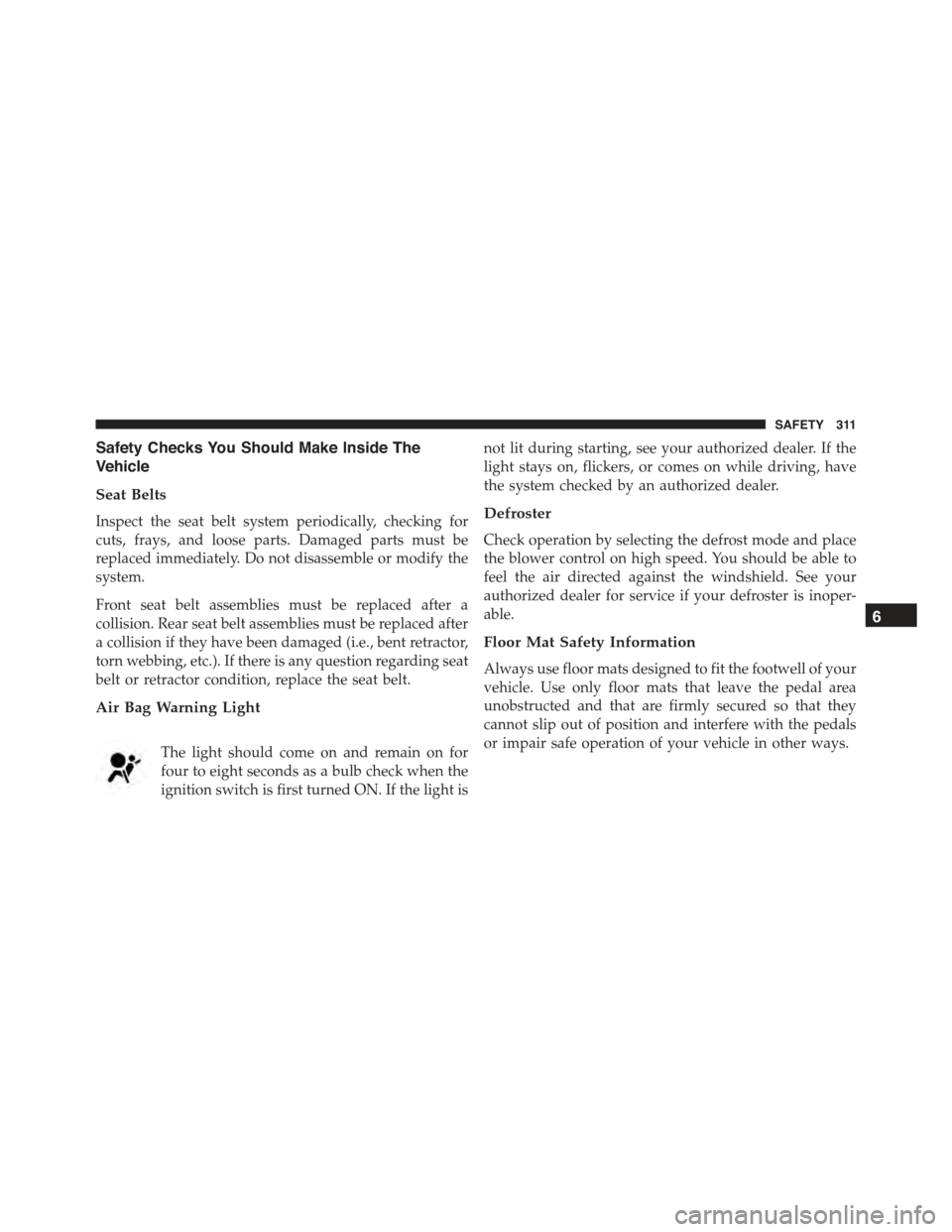
Safety Checks You Should Make Inside The
Vehicle
Seat Belts
Inspect the seat belt system periodically, checking for
cuts, frays, and loose parts. Damaged parts must be
replaced immediately. Do not disassemble or modify the
system.
Front seat belt assemblies must be replaced after a
collision. Rear seat belt assemblies must be replaced after
a collision if they have been damaged (i.e., bent retractor,
torn webbing, etc.). If there is any question regarding seat
belt or retractor condition, replace the seat belt.
Air Bag Warning Light
The light should come on and remain on for
four to eight seconds as a bulb check when the
ignition switch is first turned ON. If the light is
not lit during starting, see your authorized dealer. If the
light stays on, flickers, or comes on while driving, have
the system checked by an authorized dealer.
Defroster
Check operation by selecting the defrost mode and place
the blower control on high speed. You should be able to
feel the air directed against the windshield. See your
authorized dealer for service if your defroster is inoper-
able.
Floor Mat Safety Information
Always use floor mats designed to fit the footwell of your
vehicle. Use only floor mats that leave the pedal area
unobstructed and that are firmly secured so that they
cannot slip out of position and interfere with the pedals
or impair safe operation of your vehicle in other ways.
6
SAFETY 311